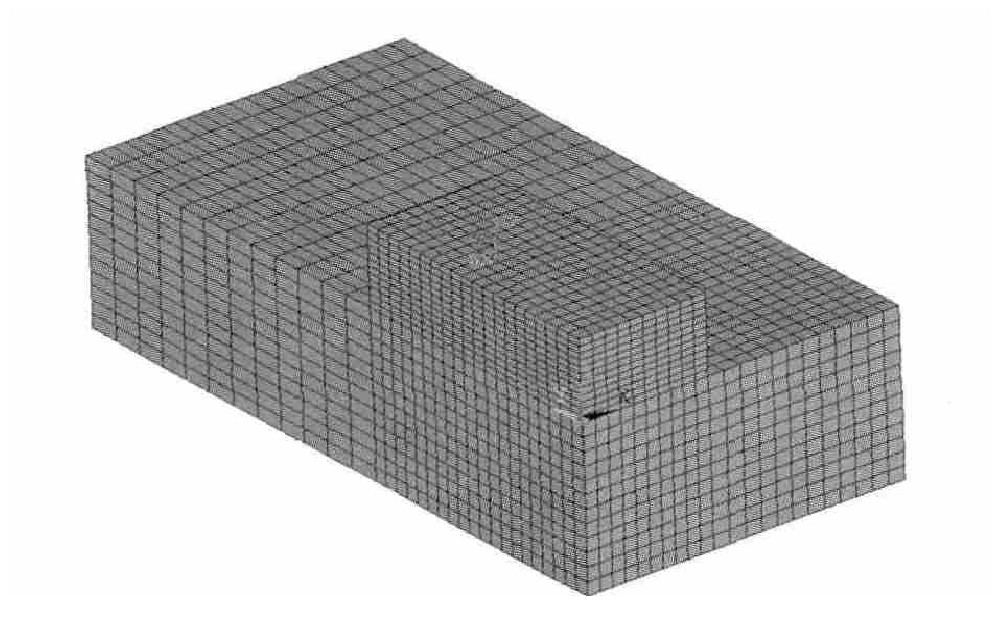Finite element simulation of inside-outside temperature gradient and thermal stress for abutment mass concrete
-
摘要: 针对大体积混凝土因水化热引起的早期开裂问题, 以内蒙古老山沟公路大桥承台为依托, 建立了大体积混凝土三维有限元模型, 分析了粉煤灰掺量、浇筑温度、环境温度与养护措施对承台中心温度、里表温差与表面拉应力的影响。模拟结果表明: 混凝土表面拉应力随粉煤灰掺量增大而减小, 当掺量超过30%时, 降幅增大, 中心温度、里表温差和表面拉应力均随其掺量增大而减小, 可见掺加粉煤灰可有效降低混凝土水化热, 防止表面温差裂缝的产生; 当浇筑温度从5℃到30℃变化时, 中心最高温度从40.3℃升至58.1℃, 里表最大温差从8.6℃升至19.0℃, 表面最大拉应力从0.93 MPa升至1.66 MPa, 且随浇筑温度的增大, 中心最高温度和里表最大温差产生的时间有所提前, 表面拉应力呈线性增大趋势; 里表温差和表面拉应力都随环境温度增大而减小, 且表面拉应力与环境温度基本呈线性关系; 养护条件越好, 里表温差越小, 表面拉应力明显降低, 且前期表面拉应力增速减慢, 峰值出现时间推迟, 有利于裂缝控制。Abstract: Aimed at the earlier temperature cracks of mass concrete during construction, a 3D finite element model of mass concrete was built based on the abutment of Laoshangou Highway Bridge in Inner Mongolia, and the effects of content of fly ash, pouring temperature, environmental temperature, and maintenance measure on central temperature, temperature difference between inside and outside, and surface tensile stress of abutment were analyzed.Simulation result shows that the surface tensile stress of concrete increases with the content decrease of fly ash, the decline increases when the content exceeds 30%, and the central temperature, the temperature difference between inside and outside, and the surface tensile stress decrease with the increasse of adding dosage of fly ash, so effective adding fly ash can reduce thehydration heat of concrete and prevent the occurrence of cracks due to the surface temperature difference.When the pouring temperature increases from 5 ℃ to 30 ℃, the highest central temperature of concrete increases from 40.3 ℃ to 58.1 ℃, the maximum temperature difference between inside and outside increases from 8.6 ℃ to 19.0 ℃, and the maximum tensile stress increases from 0.93 MPa to 1.66 MPa.The highest central temperature of concrete and the maximum temperature difference between inside and outside appear in advance, and the surface tensile stress increases linearly along with the increase of pouring temperature.The temperature difference between inside and outside and the surface tensile stress decrease with the increase of environmental temperature, and the relationship between the surface tensile stress and the environmental temperature is linear basically.The better curing condition is, the smaller the temperature difference between inside and outside is, the slower the increase speed of surface tensile stress is, the later the occurred time of maximum surface tensile stress is, which are beneficial to control the cracks.
-
Key words:
- material engineering /
- mass concrete /
- temperature field /
- thermal stress /
- numerical analysis /
- crack
-
表 1 材料计算参数
Table 1. Calculation parameters of materials

-
[1] 朱伯芳. 混凝土坝温度控制与防止裂缝的现状与展望[J]. 水利学报, 2006, 37(12): 1424-1432. doi: 10.3321/j.issn:0559-9350.2006.12.005ZHU Bo-fang. Current situation and prospect of temperature control and cracking prevention technology for concrete dam[J]. Journal of Hydraulic Engineering, 2006, 37(12): 1424-1432. (in Chinese) doi: 10.3321/j.issn:0559-9350.2006.12.005 [2] 俞亚南, 张巍, 申永刚. 大体积承台混凝土早期表面开裂控制措施[J]. 浙江大学学报: 工学版, 2010, 44(8): 1621-1628. doi: 10.3785/j.issn.1008-973X.2010.08.033YU Ya-nan, ZHANG Wei, SHEN Yong-gang. Control measures for preventing crack on the surface of mass concrete abutment in early stage[J]. Journal of Zhejiang University: Engineering Science, 2010, 44(8): 1621-1628. (in Chinese) doi: 10.3785/j.issn.1008-973X.2010.08.033 [3] LIN Feng, SONG Xiao-bin, GU Xiang-lin, et al. Cracking analysis of massive concrete walls with cracking control techniques[J]. Construction and Building Materials, 2012, 31: 12-21. doi: 10.1016/j.conbuildmat.2011.12.086 [4] YIKICI T A, CHEN Hung-liang. Use of maturity method to estimate compressive strength of mass concrete[J]. Construction and Building Materials, 2015, 95: 802-812. doi: 10.1016/j.conbuildmat.2015.07.026 [5] AMIN M N, KIM JS, LEE Y, et al. Simulation of the thermal stress in mass concrete using a thermal stressmeasuring device[J]. Cement and Concrete Research, 2009, 39(3): 154-164. doi: 10.1016/j.cemconres.2008.12.008 [6] CHU I, LEE Y, AMIN M N, et al. Application of a thermal stress device for the prediction of stresses due to hydration heat in mass concrete structure[J]. Construction and Building Materials, 2013, 45: 192-198. doi: 10.1016/j.conbuildmat.2013.03.056 [7] 罗超云, 李志生, 周立. 嘉绍大桥承台超大体积混凝土无冷却水管温控技术研究[J]. 公路, 2012(7): 101-106. doi: 10.3969/j.issn.0451-0712.2012.07.021LUO Chao-yun, LI Zhi-sheng, ZHOU Li. Technical research on temperature control of mass concrete without cooling water pipe of Jiashao Bridge pile cap[J]. Highway, 2012(7): 101-106. (in Chinese) doi: 10.3969/j.issn.0451-0712.2012.07.021 [8] ZORDAN T, BRISEGHELLA B, LIU Tao. Finite element model updating of a tied-arch bridge using Douglas-Reid method and Rosenbrock optimization algorithm[J]. Journal of Traffic and Transportation Engineering: English Edition, 2014, 1(4): 280-292. doi: 10.1016/S2095-7564(15)30273-7 [9] LIU Xing-hong, ZHANG Chao, CHANG Xiao-lin, et al. Precise simulation analysis of the thermal field in mass concrete with a pipe water cooling system[J]. Applied Thermal Engineering, 2015, 78: 449-459. doi: 10.1016/j.applthermaleng.2014.12.050 [10] BRIFFAUT M, BENBOUDJEMA F, TORRENTI J M, et al. Numerical analysis of the thermal active restrained shrinkage ring test to study the early age behavior of massive concrete structures[J]. Engineering Structures, 2011, 33(4): 1390-1401. doi: 10.1016/j.engstruct.2010.12.044 [11] MATTHIEU B, FARID B, TORRENTI JM, et al. Analysis of semi-adiabatic tests for the prediction of early-age behavior of massive concrete structures[J]. Cement and Concrete Composites, 2012, 34(5): 634-641. doi: 10.1016/j.cemconcomp.2011.09.001 [12] HA J H, JUNG Y S, CHO Y G. Thermal crack control in mass concrete structure using an automated curing system[J]. Automation in Construction, 2014, 45: 16-24. doi: 10.1016/j.autcon.2014.04.014 [13] 李潘武, 曾宪哲, 李博渊, 等. 浇筑温度对大体积混凝土温度应力的影响[J]. 长安大学学报: 自然科学版, 2011, 31(5): 68-71. https://www.cnki.com.cn/Article/CJFDTOTAL-XAGL201105013.htmLI Pan-wu, ZENG Xian-zhe, LI Bo-yuan, et al. Influence of placement temperature on mass concrete temperature stress[J]. Journal of Chang'an University: Natural Science Edition, 2011, 31(5): 68-71. (in Chinese) https://www.cnki.com.cn/Article/CJFDTOTAL-XAGL201105013.htm [14] 李涛, 张洵安, 高娃. 基于ANSYS的大体积混凝土温度应力的研究[J]. 混凝土, 2010(12): 43-46. doi: 10.3969/j.issn.1002-3550.2010.12.014LI Tao, ZHANG Xun-an, GAO Wa. Research on thermal stress of the mass concrete based on ANSYS[J]. Concrete, 2010(12): 43-46. (in Chinese) doi: 10.3969/j.issn.1002-3550.2010.12.014 [15] LI Yan, NIE Lei, WANG Bo. A numerical simulation of the temperature cracking propagation process when pouring mass concrete[J]. Automation in Construction, 2014, 37: 203-210. doi: 10.1016/j.autcon.2013.08.005 [16] 苗胜军, 丛启龙, 任奋华, 等. 基于ANSYS的大体积混凝土的水化热模拟研究[J]. 四川建筑科学研究, 2009, 35(2): 194-197. doi: 10.3969/j.issn.1008-1933.2009.02.051MIAO Sheng-jun, CONG Qi-long, REN Fen-hua, et al. Simulation study of massive concrete hydration heat based on ANSYS[J]. Sichuan Building Science, 2009, 35(2): 194-197. (in Chinese) doi: 10.3969/j.issn.1008-1933.2009.02.051 [17] KIM Y R, KHIL B S, JANG S J, et al. Effect of bariumbased phase change material(PCM)to control the heat of hydration on the mechanical properties of mass concrete[J]. Thermochimica Acta, 2015, 613: 100-107. doi: 10.1016/j.tca.2015.05.025 [18] KLEMCZAK B A. Modeling thermal-shrinkage stresses in early age massive concrete structures-comparative study of basic models[J]. Archives of Civil and Mechanical Engineering, 2014, 14(4): 721-733. doi: 10.1016/j.acme.2014.01.002 [19] 季日臣, 夏修身, 陈尧隆. 承台大体积混凝土温度场计算与温控防裂措施[J]. 混凝土, 2006(9): 92-94. doi: 10.3969/j.issn.1002-3550.2006.09.030JI Ri-chen, XIA Xiu-shen, CHEN Yao-long. Temperature field calculation and preventing crack measure in massive concrete about pillar abutment[J]. Concrete, 2006(9): 92-94. (in Chinese) doi: 10.3969/j.issn.1002-3550.2006.09.030 [20] 袁广林, 黄方意, 沈华, 等. 大体积混凝土施工期的水化热温度场及温度应力研究[J]. 混凝土, 2005(2): 86-88. doi: 10.3969/j.issn.1002-3550.2005.02.024YUAN Guang-lin, HUANG Fang-yi, SHEN Hua, et al. Research on temperature field and thermal stress of hydration heat in massive concrete of construction period[J]. Concrete, 2005(2): 86-88. (in Chinese) doi: 10.3969/j.issn.1002-3550.2005.02.024 [21] 胡昌斌, 孙增华, 王丽娟. 水泥混凝土路面早龄期温度场性状与控制方法[J]. 交通运输工程学报, 2013, 13(5): 1-9. doi: 10.3969/j.issn.1671-1637.2013.05.001HU Chang-bin, SUN Zeng-hua, WANG Li-juan. Characteristic and control method of early-age temperature field for cement concrete pavement[J]. Journal of Traffic and Transportation Engineering, 2013, 13(5): 1-9. (in Chinese) doi: 10.3969/j.issn.1671-1637.2013.05.001 [22] 闫海华, 李东, 周红兵, 等. 大型基础承台水化热分析与裂缝控制[J]. 工业建筑, 2005, 35(增): 862-866, 871. https://www.cnki.com.cn/Article/CJFDTOTAL-GYJZ2005S1257.htmYAN Hai-hua, LI Dong, ZHOU Hong-bing, et al. Hydration heat analysis and crack control of large baseplate[J]. Industrial Construction, 2005, 35(S): 862-866, 871. (in Chinese) https://www.cnki.com.cn/Article/CJFDTOTAL-GYJZ2005S1257.htm [23] HONORIO T, BARY B, BENBOUDJEMA F. Evaluation of the contribution of boundary and initial conditions in the chemo-thermal analysis of a massive concrete structure[J]. Engineering Structures, 2014, 80: 173-188. doi: 10.1016/j.engstruct.2014.08.050 -





 下载:
下载:
































